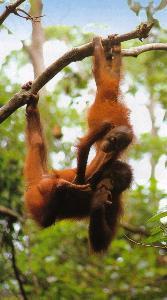
Borneo, third largest island in the world (after Greenland and New Guinea), in the Malay Archipelago, southeastern Asia. Borneo is bounded on the east by the Sulu Sea, the Celebes Sea, and the Makassar Strait; on the south by the Java Sea; and on the west and north by the South China Sea. Politically, Borneo is divided into Sabah and Sarawak, which are states of Malaysia; Brunei, an independent sultanate; and Kalimantan, part of Indonesia. The area is about 743,325 sq km (287,000 sq mi).
For the most part Borneo is mountainous, especially in the northern and central sections. Most of the peaks are between about 915 and 2285 m (about 3000 and 7500 ft) high. The island's highest peak, Mount Kinabalu (4101 m/13,455 ft), is in Sabah in the northeast. The many rivers of Borneo serve as the main arteries of internal commerce. Among the most important are the Rajang, Kapuas, Barito, and Mahakam rivers.
Borneo has a tropical climate, with an average annual temperature of about 26° C (about 78° F). Extreme humidity prevails in many parts of the island, especially in the coastal regions. Precipitation is heavy, averaging about 4064 mm (about 160 in) annually for the island as a whole and considerably more in some localities. Maximum precipitation occurs between October and May, the period of the northeastern monsoon. There is no dry season. Vegetation is luxuriant and highly diversified. In the mountain regions rhododendron, orchid, pitcher plant, and other flowering plants grow in great profusion. Indigenous fruit trees include the coconut palm, orange, banana, and mango. More than 50 species of timber trees grow in the dense forests, notably teak, ironwood, ebony, and sandalwood.

Elephants and rhinoceroses live in the northern portion of the island, as do the orangutan, gibbon, proboscis monkey, and wild ox. Among the smaller quadrupeds are several species of macaque monkey, tiger cat, tapir, honey bear, porcupine, flying squirrel, flying fox, and various species of deer. Reptiles include the crocodile, many varieties of lizard, and the python and numerous other species of snakes. Eagles, falcons, vultures, parrots, peacocks, flamingoes, and hornbills are among the birds found here. The main mineral resource of the island is petroleum, found primarily in Brunei and along the east coast near Balikpapan. Other minerals include coal, gold, copper, tin, iron, manganese, antimony, bauxite, gypsum, marble, rock salt, mercury, diamonds, and sulfur. Agricultural products include rice, millet, maize, manioc, sweet potatoes, yams, sugarcane, cucumbers, pumpkin, and tropical fruits. Such products as rubber, coconuts, tobacco, manila hemp, pepper, coffee, cinnamon, and camphor are cultivated for export.
With a population of about 12.5 million (1991 estimate), the island is rather sparsely populated. Principal cities include Banjarmasin, Pontianak, and Balikpapan in Indonesian Borneo and Kuching in Sarawak. The population consists of three main groups: the Dayaks, the aboriginal inhabitants; the largely Muslim Malays, whose chief occupations are trading, farming, and fishing; and the Chinese, who are mainly traders. The number of Indonesians has been increasing, particularly in Central Kalimantan Province of Indonesian Borneo, since the government of Indonesia began offering assistance to citizens wishing to migrate from densely populated areas of the island of Java. Few Europeans, Eurasians, or Indians inhabit Borneo.
Borneo's early history is obscure, but inscriptions at Kutei, dating from about AD 400, show the first traces of Indian influence. The Sumatra-based kingdom of Sri Vijaya long exerted influence over the western coastal regions, and in the 14th century the Majapahit Empire of Java claimed control of Banjarmasin and much of southern Borneo (see Majapahit, Kingdom of; Sri Vijaya, Kingdom of). The Muslim sultanate of Brunei, founded in the late 15th century, dominated northern Borneo and the Sulu Archipelago during the following century.
From the 17th to the 19th century, the British and Dutch made sporadic attempts to control the island's trade, particularly in pepper. In the mid-18th century, Chinese immigrants established gold-mining communities in western Borneo, but the settlements were destroyed by the Dutch in 1854. Many of the Chinese then turned to agriculture and trade. During the 19th century the Dutch imposed treaties on some south- and west-coast rulers who ceded vast territories to them, but Dutch authority in the interior was minimal.
British traders established footholds along the northern coast, most of which was under the Brunei sultanate. When a British adventurer, James Brooke, assisted the sultan in suppressing a rebellion in 1841, the sultan granted him the title of raja and the Sarawak district of Brunei (see Brooke, Sir James). Brooke asserted Sarawak's independence in 1853, and he and his heir extended the state's borders at Brunei's expense. From 1881 a company chartered by the British crown administered North Borneo (now Sabah), which in 1888, along with Brunei and Sarawak, was made a British protectorate. The Japanese occupied much of Borneo from 1942 to 1945, after which all three protectorates were made British crown colonies. The Dutch transferred sovereignty of the southern regions (Kalimantan) to Indonesia at the end of 1949. In 1963 Sarawak and Sabah merged with peninsular Malaya to form the Federation of Malaysia, but the sultanate of Brunei remained a British protectorate. Indonesia initially opposed Malaysia's formation and supported guerrilla attacks into Sarawak and Sabah until 1966, when it accepted the new federation. In keeping with agreements negotiated between Brunei and Great Britain in the late 1970s, Brunei became fully independent as of January 1, 1984.
![]() States
States
![]() Tourism
Tourism
![]() National Symbols
National Symbols
![]() History
History
![]() Geography
Geography
![]() Flora & Fauna
Flora & Fauna
![]() Economy
Economy
![]() Culture
Culture
![]() Festivals
Festivals
![]() Transportation
Transportation
![]() Accommodation
Accommodation
![]() Foreign Exchange
Foreign Exchange
![]() Food
Food
![]() Fruits
Fruits